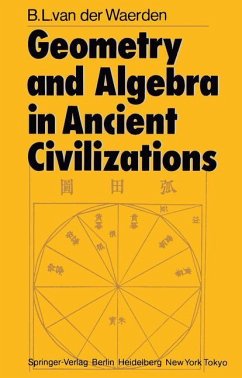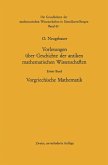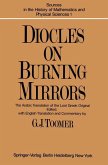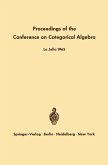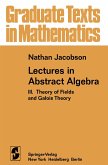Bartel L. van der Waerden
Geometry and Algebra in Ancient Civilizations
Bartel L. van der Waerden
Geometry and Algebra in Ancient Civilizations
- Broschiertes Buch
- Merkliste
- Auf die Merkliste
- Bewerten Bewerten
- Teilen
- Produkt teilen
- Produkterinnerung
- Produkterinnerung
Originally, my intention was to write a "History of Algebra", in two or three volumes. In preparing the first volume I saw that in ancient civiliza tions geometry and algebra cannot well be separated: more and more sec tions on ancient geometry were added. Hence the new title of the book: "Geometry and Algebra in Ancient Civilizations". A subsequent volume on the history of modem algebra is in preparation. It will deal mainly with field theory, Galois theory and theory of groups. I want to express my deeply felt gratitude to all those who helped me in shaping this volume. In particular, I want…mehr
Andere Kunden interessierten sich auch für
![Mathematik in Antike und Orient Mathematik in Antike und Orient]() Helmuth GerickeMathematik in Antike und Orient69,99 €
Helmuth GerickeMathematik in Antike und Orient69,99 €![Vorlesungen über Geschichte der antiken mathematischen Wissenschaften Vorlesungen über Geschichte der antiken mathematischen Wissenschaften]() Otto NeugebauerVorlesungen über Geschichte der antiken mathematischen Wissenschaften54,99 €
Otto NeugebauerVorlesungen über Geschichte der antiken mathematischen Wissenschaften54,99 €![DIOCLES, On Burning Mirrors DIOCLES, On Burning Mirrors]() DIOCLES, On Burning Mirrors79,99 €
DIOCLES, On Burning Mirrors79,99 €![Proceedings of the Conference on Categorical Algebra Proceedings of the Conference on Categorical Algebra]() Proceedings of the Conference on Categorical Algebra40,99 €
Proceedings of the Conference on Categorical Algebra40,99 €![Women in Numbers Europe Women in Numbers Europe]() Women in Numbers Europe110,99 €
Women in Numbers Europe110,99 €![An Exhibit Denied An Exhibit Denied]() Martin HarwitAn Exhibit Denied36,99 €
Martin HarwitAn Exhibit Denied36,99 €![Lectures in Abstract Algebra Lectures in Abstract Algebra]() N. JacobsonLectures in Abstract Algebra63,99 €
N. JacobsonLectures in Abstract Algebra63,99 €-
-
-
Originally, my intention was to write a "History of Algebra", in two or three volumes. In preparing the first volume I saw that in ancient civiliza tions geometry and algebra cannot well be separated: more and more sec tions on ancient geometry were added. Hence the new title of the book: "Geometry and Algebra in Ancient Civilizations". A subsequent volume on the history of modem algebra is in preparation. It will deal mainly with field theory, Galois theory and theory of groups. I want to express my deeply felt gratitude to all those who helped me in shaping this volume. In particular, I want to thank Donald Blackmore Wagner (Berkeley) who put at my disposal his English translation of the most interesting parts of the Chinese "Nine Chapters of the Art of Arith metic" and of Liu Hui's commentary to this classic, and also Jacques Se siano (Geneva), who kindly allowed me to use his translation of the re cently discovered Arabic text of four books of Diophantos not extant in Greek. Warm thanks are also due to Wyllis Bandler (Colchester, England) who read my English text very carefully and suggested several improve ments, and to Annemarie Fellmann (Frankfurt) and Erwin Neuenschwan der (Zurich) who helped me in correcting the proof sheets. Miss Fellmann also typed the manuscript and drew the figures. I also want to thank the editorial staff and production department of Springer-Verlag for their nice cooperation.
Hinweis: Dieser Artikel kann nur an eine deutsche Lieferadresse ausgeliefert werden.
Hinweis: Dieser Artikel kann nur an eine deutsche Lieferadresse ausgeliefert werden.
Produktdetails
- Produktdetails
- Verlag: Springer / Springer Berlin Heidelberg / Springer, Berlin
- Softcover reprint of the original 1st ed. 1983
- Seitenzahl: 244
- Erscheinungstermin: 8. Oktober 2011
- Englisch
- Abmessung: 244mm x 156mm x 14mm
- Gewicht: 392g
- ISBN-13: 9783642617812
- ISBN-10: 3642617816
- Artikelnr.: 36115294
- Verlag: Springer / Springer Berlin Heidelberg / Springer, Berlin
- Softcover reprint of the original 1st ed. 1983
- Seitenzahl: 244
- Erscheinungstermin: 8. Oktober 2011
- Englisch
- Abmessung: 244mm x 156mm x 14mm
- Gewicht: 392g
- ISBN-13: 9783642617812
- ISBN-10: 3642617816
- Artikelnr.: 36115294
Bartel van der Waerden, geb. am 2.2.1903 in Amsterdam, ging 1924 ging als Student nach Göttingen und wurde dort mit Emmy Noether und der abstrakten Algebra bekannt. Sein Hauptinteresse galt damals vor allem der Begründung der algebraischen Geometrie mit Hilfe der neuen algebraischen Methoden. Als er im Jahre 1926 als junger Doktor mit einem Rockefeller-Stipendium nach Hamburg kam, hatte er Gelegenheit, eine didaktisch hervorragende Algebra-Vorlesung von Emil Artin zu hören. Die Ausarbeitung, die er von dieser Vorlesung machte, wurde zum Kern des vorliegenden Werkes. Es erschien zuerst 1930-31 unter dem Titel 'Moderne Algebra' in der Sammlung 'Grundlehren der mathematischen Wissenschaften'. In der Folge wurde das Werk in die englische, russische und chinesische Sprache übersetzt. Im Jahre 1928 wurde der Autor Professor an der Universität Groningen. Seit 1951 lebte und arbeitete er bis zu seiner Emeritierung in Zürich als Professor an der dortigen Universität.
1. Pythagorean Triangles.- A. Written Sources.- Fundamental Notions.- The Text Plimpton 322.- A Chinese Method.- Methods Ascribed to Pythagoras and Plato.- Pythagorean Triples in India.- The Hypothesis of a Common Origin.- Geometry and Ritual in Greece and India.- Pythagoras and the Ox.- B. Archaeological Evidence.- Prehistoric Ages.- Radiocarbon Dating.- Megalithic Monuments in Western Europe.- Pythagorean Triples in Megalithic Monuments.- Megalith Architecture in Egypt.- The Ritual Use of Pythagorean Triangles in India.- C. On Proofs, and on the Origin of Mathematics.- Geometrical Proofs.- Euclid's Proof.- Naber's Proof.- Astronomical Applications of the Theorem of Pythagoras?.- Why Pythagorean Triangles?.- The Origin of Mathematics.- 2. Chinese and Babylonian Mathematics.- A. Chinese Mathematics.- The Chinese "Nine Chapters".- The Euclidean Algorithm.- Areas of Plane Figures.- Volumes of Solids.- The Moscow Papyrus.- Similarities Between Ancient Civilizations.- Square Roots and Cube Roots.- Sets of Linear Equations.- Problems on Right-Angled Triangles.- The Broken Bamboo.- Two Geometrical Problems.- Parallel Lines in Triangles.- B. Babylonian Mathematics.- A Babylonian Problem Text.- Quadratic Equations in Babylonian Texts.- The Method of Elimination.- The "Sum and Difference" Method.- C. General Conclusions.- Chinese and Babylonian Algebra Compared.- The Historical Development.- 3. Greek Algebra.- What is Algebra?.- The Role of Geometry in Elementary Algebra.- Three Kinds of Algebra.- On Units of Length, Area, and Volume.- Greek "Geometric Algebra".- Euclid's Second Book.- The Application of Areas.- Three Types of Quadratic Equations.- Another Concordance Between the Babylonians and Euclid.- An Application of II, 10 to Sides and Diagonals.- Thalesand Pythagoras.- The Geometrization of Algebra.- The Theory of Proportions.- Geometric Algebra in the "Konika" of Apollonios.- The Sum of a Geometrical Progression.- Sums of Squares and Cubes.- 4. Diophantos and his Predecessors.- A. The Work of Diophantos.- Diophantos' Algebraic Symbolism.- Determinate and Indeterminate Problems.- From Book A.- From Book B.- The Method of Double Equality.- From Book ?.- From Book 4.- From Book 5.- From Book 7.- From Book ?.- From Book E.- B. The Michigan Papyrus 620.- C. Indeterminate Equations in the Heronic Collections.- 5. Diophantine Equations.- A. Linear Diophantine Equations.- Aryabhata's Method.- Linear Diophantine Equations in Chinese Mathematics.- The Chinese Remainder Problem.- Astronomical Applications of the Pulverizer.- Aryabhata's Two Systems.- Brahmagupta's System.- The Motion of the Apogees and Nodes.- The Motion of the Planets.- The Influence of Hellenistic Ideas.- B. PelVs Equation.- The Equation x2= 2y2±l.- Periodicity in the Euclidean Algorithm.- Reciprocal Subtraction.- The Equations x2= 3y2 +1 and x2= 3y2- 2.- Archimedes' Upper and Lower Limits for w3.- Continued Fractions.- The Equation x2= Dy2± 1 for Non-squareD.- Brahmagupta's Method.- The Cyclic Method.- Comparison Between Greek and Hindu Methods.- C. Pythagorean Triples.- 6. Popular Mathematics.- A. General Character of Popular Mathematics.- B. Babylonian, Egyptian and Early Greek Problems.- Two Babylonian Problems.- Egyptian Problems.- The "Bloom of Thymaridas".- C. Greek Arithmetical Epigrams.- D. Mathematical Papyri from Hellenistic Egypt.- Calculations with Fractions.- Problems on Pieces of Cloth.- Problems on Right-Angled Triangles.- Approximation of Square Roots.- Two More Problems of Babylonian Type.- E. Squaring the Circleand Circling the Square.- An Ancient Egyptian Rule for Squaring the Circle.- Circling the Square as a Ritual Problem.- An Egyptian Problem.- Area of the Circumscribed Circle of a Triangle.- Area of the Circumscribed Circle of a Square.- Three Problems Concerning the Circle Segment in a Babylonian Text.- Shen Kua on the Arc of a Circle Segment.- F. Heron of Alexandria.- The Date of Heron.- Heron's Commentary to Euclid.- Heron's Metrika.- Circles and Circle Segments.- Apollonios' Rapid Method.- Volumes of Solids.- Approximating a Cube Root.- G. The Mishnat ha-Middot.- 7. Liu Hui and Aryabhata.- A. The Geometry of Liu Hui.- The "Classic of the Island in the Sea".- First Problem: The Island in the Sea.- Second Problem: Height of a Tree.- Third Problem: Square Town.- The Evaluation of ?.- The Volume of a Pyramid.- Liu Hui and Euclid.- Liu Hui on the Volume of a Sphere.- B. The Mathematics of Aryabhata.- Area and Circumference of a Circle.- Aryabhata's Table of Sines.- On the Origin of Aryabhata's Trigonometry.- Apollonios and Aryabhata as Astronomers.- On Gnomons and Shadows.- Square Roots and Cube Roots.- Arithmetical Progressions and Quadratic Equations.
1. Pythagorean Triangles.- A. Written Sources.- Fundamental Notions.- The Text Plimpton 322.- A Chinese Method.- Methods Ascribed to Pythagoras and Plato.- Pythagorean Triples in India.- The Hypothesis of a Common Origin.- Geometry and Ritual in Greece and India.- Pythagoras and the Ox.- B. Archaeological Evidence.- Prehistoric Ages.- Radiocarbon Dating.- Megalithic Monuments in Western Europe.- Pythagorean Triples in Megalithic Monuments.- Megalith Architecture in Egypt.- The Ritual Use of Pythagorean Triangles in India.- C. On Proofs, and on the Origin of Mathematics.- Geometrical Proofs.- Euclid's Proof.- Naber's Proof.- Astronomical Applications of the Theorem of Pythagoras?.- Why Pythagorean Triangles?.- The Origin of Mathematics.- 2. Chinese and Babylonian Mathematics.- A. Chinese Mathematics.- The Chinese "Nine Chapters".- The Euclidean Algorithm.- Areas of Plane Figures.- Volumes of Solids.- The Moscow Papyrus.- Similarities Between Ancient Civilizations.- Square Roots and Cube Roots.- Sets of Linear Equations.- Problems on Right-Angled Triangles.- The Broken Bamboo.- Two Geometrical Problems.- Parallel Lines in Triangles.- B. Babylonian Mathematics.- A Babylonian Problem Text.- Quadratic Equations in Babylonian Texts.- The Method of Elimination.- The "Sum and Difference" Method.- C. General Conclusions.- Chinese and Babylonian Algebra Compared.- The Historical Development.- 3. Greek Algebra.- What is Algebra?.- The Role of Geometry in Elementary Algebra.- Three Kinds of Algebra.- On Units of Length, Area, and Volume.- Greek "Geometric Algebra".- Euclid's Second Book.- The Application of Areas.- Three Types of Quadratic Equations.- Another Concordance Between the Babylonians and Euclid.- An Application of II, 10 to Sides and Diagonals.- Thalesand Pythagoras.- The Geometrization of Algebra.- The Theory of Proportions.- Geometric Algebra in the "Konika" of Apollonios.- The Sum of a Geometrical Progression.- Sums of Squares and Cubes.- 4. Diophantos and his Predecessors.- A. The Work of Diophantos.- Diophantos' Algebraic Symbolism.- Determinate and Indeterminate Problems.- From Book A.- From Book B.- The Method of Double Equality.- From Book ?.- From Book 4.- From Book 5.- From Book 7.- From Book ?.- From Book E.- B. The Michigan Papyrus 620.- C. Indeterminate Equations in the Heronic Collections.- 5. Diophantine Equations.- A. Linear Diophantine Equations.- Aryabhata's Method.- Linear Diophantine Equations in Chinese Mathematics.- The Chinese Remainder Problem.- Astronomical Applications of the Pulverizer.- Aryabhata's Two Systems.- Brahmagupta's System.- The Motion of the Apogees and Nodes.- The Motion of the Planets.- The Influence of Hellenistic Ideas.- B. PelVs Equation.- The Equation x2= 2y2±l.- Periodicity in the Euclidean Algorithm.- Reciprocal Subtraction.- The Equations x2= 3y2 +1 and x2= 3y2- 2.- Archimedes' Upper and Lower Limits for w3.- Continued Fractions.- The Equation x2= Dy2± 1 for Non-squareD.- Brahmagupta's Method.- The Cyclic Method.- Comparison Between Greek and Hindu Methods.- C. Pythagorean Triples.- 6. Popular Mathematics.- A. General Character of Popular Mathematics.- B. Babylonian, Egyptian and Early Greek Problems.- Two Babylonian Problems.- Egyptian Problems.- The "Bloom of Thymaridas".- C. Greek Arithmetical Epigrams.- D. Mathematical Papyri from Hellenistic Egypt.- Calculations with Fractions.- Problems on Pieces of Cloth.- Problems on Right-Angled Triangles.- Approximation of Square Roots.- Two More Problems of Babylonian Type.- E. Squaring the Circleand Circling the Square.- An Ancient Egyptian Rule for Squaring the Circle.- Circling the Square as a Ritual Problem.- An Egyptian Problem.- Area of the Circumscribed Circle of a Triangle.- Area of the Circumscribed Circle of a Square.- Three Problems Concerning the Circle Segment in a Babylonian Text.- Shen Kua on the Arc of a Circle Segment.- F. Heron of Alexandria.- The Date of Heron.- Heron's Commentary to Euclid.- Heron's Metrika.- Circles and Circle Segments.- Apollonios' Rapid Method.- Volumes of Solids.- Approximating a Cube Root.- G. The Mishnat ha-Middot.- 7. Liu Hui and Aryabhata.- A. The Geometry of Liu Hui.- The "Classic of the Island in the Sea".- First Problem: The Island in the Sea.- Second Problem: Height of a Tree.- Third Problem: Square Town.- The Evaluation of ?.- The Volume of a Pyramid.- Liu Hui and Euclid.- Liu Hui on the Volume of a Sphere.- B. The Mathematics of Aryabhata.- Area and Circumference of a Circle.- Aryabhata's Table of Sines.- On the Origin of Aryabhata's Trigonometry.- Apollonios and Aryabhata as Astronomers.- On Gnomons and Shadows.- Square Roots and Cube Roots.- Arithmetical Progressions and Quadratic Equations.
